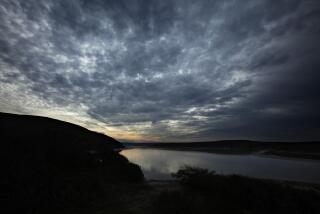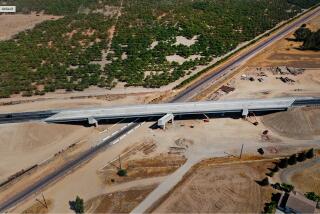County in Running to Get Scientific Research Facility
- Share via
Eighteen sites in 17 states, including one in eastern Los Angeles County, have been proposed for the construction of two gravity wave observatories, a cutting-edge science project that will test part of Einstein’s theory of general relativity, Caltech announced Monday.
The $211-million project will attempt to detect something no one has been able to detect before--gravity waves that Einstein theorized should be sent out by cataclysmic events throughout the universe.
The ambitious project could be one of the major scientific endeavors of this decade, but to succeed scientists will have to build two observatories that will measure movement on a scale that has never been achieved before. A small model of the large observatories has been undergoing tests at Caltech for several years, and it is so sensitive that it can measure movement of one-millionth the diameter of an atom.
But that performance will have to be improved dramatically for the Laser Interferometer Gravitational-Wave Observatory (LIGO), which is to be a joint project of Caltech and the Massachusetts Institute of Technology, funded by the National Science Foundation. LIGO will use two gravity wave detectors at least 1,500 miles apart. The separation is necessary for scientists to screen out movement caused by local disturbances.
Since such things as earthquakes and trains and even surf conditions could hinder the operations of the observatories, the list will be narrowed to candidates that are seismically and acoustically quiet, yet not too far from housing and support facilities for the small staffs.
Caltech, the lead institution in the project, asked all 50 states to propose sites on which the observatories could be built. Each observatory will consist of two vacuum pipes, 4 feet in diameter and 2.5 miles long.
California has only one candidate on the list, near the city of Pearblossom in eastern Los Angeles County. Only one state, New Mexico, proposed two sites. The other sites are in Idaho, Kansas, Louisiana, Maine, Mississippi, Montana, Nebraska, New York, North Dakota, South Carolina, Tennessee, Utah, Washington, West Virginia and Wyoming.
The project was approved by the National Science Foundation in May, 1990, and officials hope that construction will begin in 1992.
The observatory could open a new “window on the universe,” according to project director Rochus Vogt of Caltech. It will be designed to measure gravity waves, which are different from the familiar form of gravity that causes objects to attract each other.
Albert Einstein postulated in his general theory of relativity that such things as the collision of two black holes or the collapsing of a star would radiate gravity waves that would cause other objects to move ever so slightly, even if they are millions of light years away.
Research at Caltech and MIT has shown that such waves should cause objects suspended in a vacuum to move as the waves pass through them. The observatory is designed to detect a change in the distance between suspended weights caused by the waves passing through them.
But to succeed, the observatories will have to measure a change no more than one one-hundred-millionth the diameter of a hydrogen atom, something no one has been able to do.
More to Read
Sign up for Essential California
The most important California stories and recommendations in your inbox every morning.
You may occasionally receive promotional content from the Los Angeles Times.













